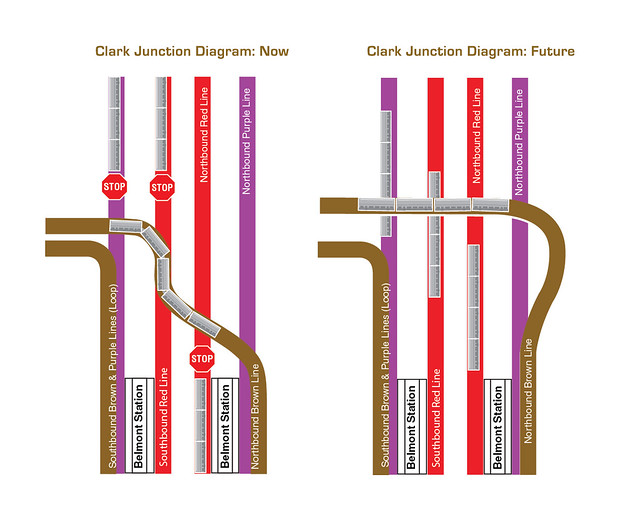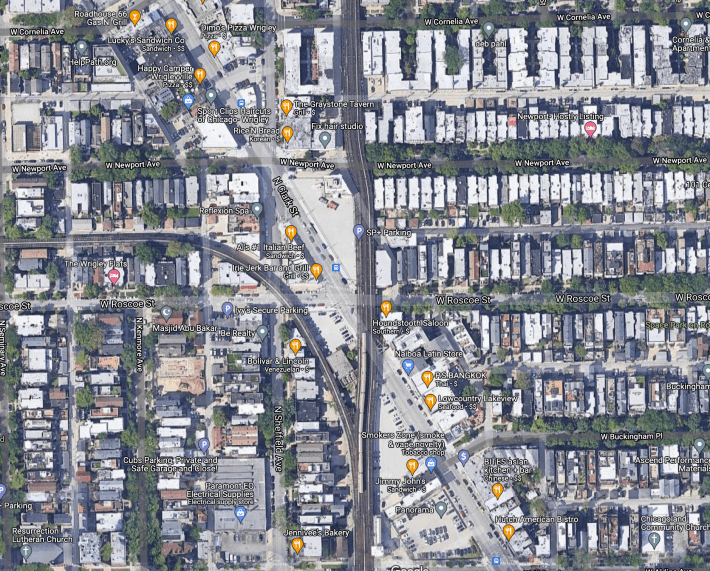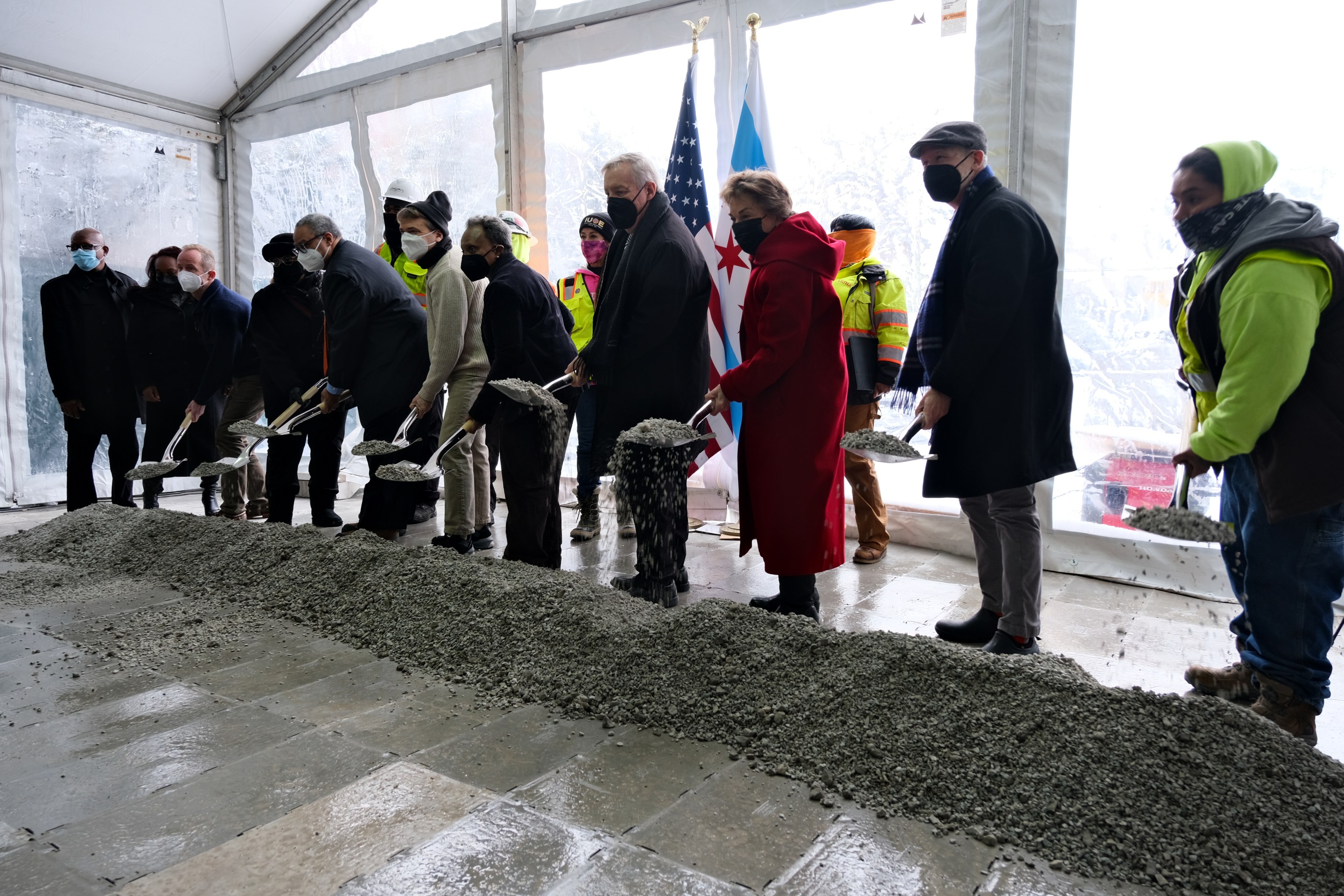With the debut of the CTA's $320 million Belmont Flyover, aka the Red-Purple Bypass, on November 18, the city of Chicago closed one chapter of the $2.1 billion first phase of the Red and Purple Modernization program. Yesterday officials opened a new chapter with a groundbreaking ceremony for the demolition, reconstruction, and realignment of the 100-year-old Red and Purple Line tracks between Belmont (3200 N.) and Cornelia Avenue (3500 N.) The CTA says that, like the flyover, the $250 million track project will allow the agency to run more trains during rush hours. The work is slated to wrap up in 2025.
”The reconstruction of the Red Line in our transportation and trail system has been long overdue," said Mayor Lori Lightfoot in a statement. "Our city and our residents deserve an easily accessible and reliable CTA commute, and I’m thrilled to see the continued improvement and modernization of one of the busiest 'L' lines. I’m proud of the progress CTA has made with the RPM project and beyond confident this bypass will benefit every single person who uses our transit system in the City.”
The flyover got rid of a 115-year-old rail intersection of the Red, Purple, and Brown lines that carried about 150,000 rides each weekday prior to the COVID-19 pandemic. Red and Purple trains formerly had to wait when northbound Brown trains turned west across the north-south tracks, which the CTA said was a bottleneck for service across the entire rail system. The agency has promised that by unclogging the so-called Clark Junction, the flyover will enable the addition of up to eight more Red Line trains, carrying 30 percent (7,200) more riders per hour during rush periods.
The bypass is probably also shaving a little time off commutes, since the trains were typically delayed by a couple dozen seconds as they waited for other lines to pass. (Former mayor Rahm Emanuel exaggerated the potential time savings as “three to four minutes” during a 2014 press conference.)

“The Red and Purple Modernization program is a transformational project that will allow the CTA to provide more accessible and reliable service for decades to come,” U.S. Senator Dick Durbin said in a statement. “The progress that we’re celebrating today is due in large part to the more than $1 billion in federal funding that the Chicago Congressional delegation worked to bring to Chicago for these infrastructure improvements. I’ve been proud to support the RPM program and I will continue to advocate on behalf of the people of Illinois to bring more federal funds home to support our transit systems.” Local Congressional reps Mike Quigley, a member of the House Appropriations Committee who helped secure the federal funding, and Jan Schakowsky also lauded the project.
“Our customers will see a noticeable improvement in CTA service, with increased access to trains, shorter commute times and less crowding on trains and station platforms,” said CTA President Dorval R. Carter, Jr. in a statement. “I thank Mayor Lightfoot, Sen. Durbin and the Illinois congressional delegation for supporting this project and making it possible to build RPM. What’s more, I’m proud that the benefits of RPM extend beyond Red and Purple Line riders to the small businesses and workers across the city that are participating in this project – creating an unmatched model for job training and contract opportunities that is contributing to greater inclusion and equity in Chicago.”

The Belmont-to-Cornelia track reconstruction will begin next month. According to the CTA, the curve in these century-old tracks slow down trains, and rebuilding and straightening them will allow for faster speeds, better reliability, and a more comfortable ride.
Other aspects of RPM Phase One include reconstruction of the Lawrence, Argyle, Berwyn and Bryn Mawr Red Line stations into larger wheelchair-accessible stations, and the replacement of a total of six miles of track structures. That work began in spring 2021, with new stations projected to open by the end of 2024. The CTA is also installing a new signal system on 23 track miles between Howard and Belmont.
While the RPM program has caused some inconvenience for residents and merchants – particularly the closure of the Lawrence and Berwyn stations since May 16 – the city is touting the economic benefits of the project. Officials said the CTA works with two workforce assistance agencies, HIRE360 and the Chicago Cook Workforce Partnership, to recruit low-income residents for construction jobs. The city has also hosted open houses with local contractors and trade unions, plus Tracks to Trades, a webinar series to provide info to Chicago Public School high school students on the construction industry and how to find work in the building trades after graduation. In 2020 the CTA launched the annual CTA Elevating Futures Scholarship Fund to provide scholarships to low-income Chicago students to help them pursue construction and engineering degrees.
The transit agency says it also launched the CTA Building Small Businesses program in 2019 to increase the number of small businesses participating in RPM and other major infrastructure projects. The agency says the program has provided technical and funding help to over 100 small businesses.
For more information about the RPM project, visit transitchicago.com/RPM. To sign up for project alerts, visit transitchicago.com/rpm/alerts.






